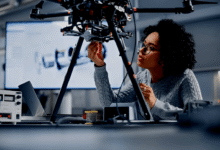IoT and Healthcare: How Smart Devices are Transforming the Medical Industry in 2023

Smart Devices are Transforming
In this article, we’ll explore how IoT is changing the medical industry and the benefits it brings to patients, healthcare providers, Smart Devices are Transforming and the industry as a whole. As technology continues to advance, it’s no surprise that the healthcare industry is being transformed by the Internet of Things (IoT). Smart devices, which are connected to the internet and can communicate with each other, are being used to improve patient care, monitor vital signs, and automate routine tasks.
What is IoT and how does it work in healthcare?
IoT refers to the interconnection of smart devices and objects that can communicate with each other without human intervention. In healthcare, IoT devices can be used to collect data from patients, monitor their health status, and automate certain tasks. These devices can be anything from wearable sensors to smart hospital beds, and they all work together to create a network of information that can be analyzed and used to improve patient outcomes.
The way IoT works in healthcare is simple. First, data is collected from various sources such as patients, medical devices, and hospital systems. This data is then transmitted to a central database where it can be analyzed and processed in real-time. Finally, the results of this analysis are fed back to healthcare providers who can use them to make informed decisions about patient care.
Benefits of IoT in healthcare
IoT is transforming the medical industry in a number of ways, and the benefits are numerous. Here are just a few of the ways IoT is improving patient care and the healthcare industry:
Remote monitoring of patients
IoT devices can be used to remotely monitor patients, which is especially useful for those with chronic conditions or who live in remote areas. Wearable devices can track vital signs such as heart rate, blood pressure, and oxygen levels, and this information can be transmitted to healthcare providers in real-time. This allows healthcare providers to monitor patients more closely and make informed decisions about their care.
Improved patient outcomes
By collecting and analyzing data in real-time, healthcare providers can use this information to make more informed decisions about patient care. This can lead to improved patient outcomes and better overall health for patients.
Increased efficiency
IoT devices can automate many routine tasks, such as taking vital signs, scheduling appointments, and ordering medications. This frees up healthcare providers to focus on more important tasks, such as patient care and treatment.
Reduced costs
By automating routine tasks and improving patient outcomes, IoT can also help reduce costs in the healthcare industry. This can lead to lower healthcare costs for patients and a more efficient healthcare system overall.
Examples of IoT devices in healthcare
There are many different types of IoT devices being used in healthcare today. Here are just a few examples:
Wearable sensors
Wearable sensors are perhaps the most common type of IoT device in healthcare. These devices can be worn by patients and can track vital signs such as heart rate, blood pressure, and oxygen levels. This information can be transmitted to healthcare providers in real-time, allowing them to monitor patients more closely.
Smart hospital beds
Smart hospital beds are another example of IoT devices being used in healthcare. These beds can automatically adjust to the patient’s position, making them more comfortable and reducing the risk of bedsores. They can also track vital signs and other health metrics, providing healthcare providers with valuable data.
Automated medication dispensers
Automated medication dispensers are another example of IoT devices being used in healthcare. These devices can be programmed to dispense medication at specific times, ensuring patients receive the correct dosage at the right time.
Challenges of IoT in healthcare
While IoT is transforming the healthcare industry, there are also a number of challenges that must be addressed. Here are just a few:
Security
With so much sensitive data being transmitted between devices, security is a major concern in healthcare IoT.
Interoperability
With so many different IoT devices being used in healthcare, it can be difficult to ensure they all work together seamlessly. Interoperability is a major challenge, as devices from different manufacturers may not be compatible with each other.
Privacy
With so much personal health data being collected and transmitted, privacy is another major concern. Healthcare providers must ensure that patient data is kept secure and only accessed by authorized individuals.
Training and education
Finally, healthcare providers must be trained and educated on how to use IoT devices effectively. This includes understanding how to interpret data, how to use IoT devices in patient care, and how to address any issues that may arise.
Read More:5G Technology: The Key to Unlocking the Full Potential of the IoT
Conclusion
The Internet of Things is transforming the healthcare industry in a number of ways, from remote patient monitoring to improved patient outcomes and increased efficiency. While there are certainly challenges to be addressed, the benefits of IoT in healthcare are clear. By embracing this technology, healthcare providers can improve patient care, reduce costs, and create a more efficient healthcare system overall. As IoT continues to evolve, it will be exciting to see how it will shape the future of healthcare.











